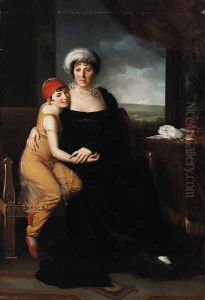Marie-Eleonore Godefroy Paintings
Marie-Éléonore Godefroy was a French artist born in 1778, during a period that was marked by the social and political changes of the French Revolution. She was a part of the Godefroy family, which included several artists, and was the niece of the esteemed French painter Jean-Léonard Godefroy. Despite the societal challenges and the limitations placed on women in the arts during the 18th and 19th centuries, Godefroy managed to pursue her passion for painting.
Marie-Éléonore Godefroy's artistic journey was influenced by her uncle, from whom she likely received her initial training. Her works were primarily in the realm of portraiture, a genre that was particularly accessible to women artists at the time. She exhibited her paintings at the Paris Salon, a prestigious venue for artists to showcase their works to the public and critics alike. Godefroy's participation in the Salon highlights her recognition and acceptance within the artistic community, despite the gender biases of the era.
Godefroy's style was characteristic of the neoclassical movement, which emphasized clarity, order, and idealized beauty. Neoclassicism was a dominant style in France during her lifetime, particularly under the reign of Napoleon Bonaparte. Her portraits often depicted individuals in a refined and polished manner, reflecting the aesthetics of the time.
Despite the challenges faced by women in the arts, Godefroy managed to gain some prominence and respect as an artist. However, like many female artists of her time, her work was often overshadowed by that of her male counterparts, and as a result, she is not as well-known today. Marie-Éléonore Godefroy's death in 1849 marked the end of her life's work, but she left behind a legacy that contributes to our understanding of the role of women in the art world of post-revolutionary France.
